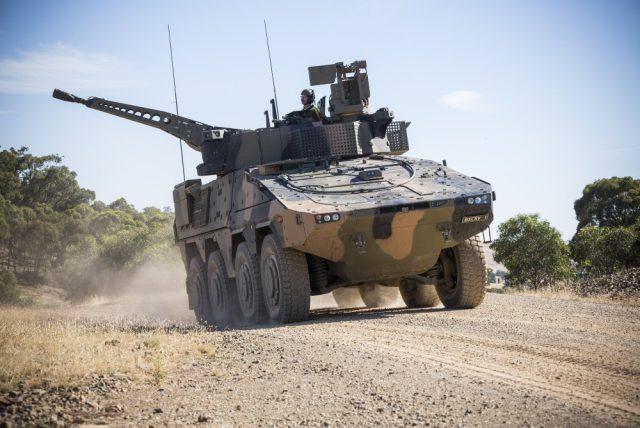
The government has made its long-awaited decision on the first phase of LAND 400, Defence’s megaproject to acquire new armoured combat vehicles. And the even bigger decision on the future frigate is likely soon to follow.
The successful tenderer for the combat reconnaissance vehicle was Rheinmetall’s Boxer. It’s not clear yet why the government chose the Boxer over its competition, BAE’s AMV35. While the prime minister stated the number of jobs that would be created, he said that the selection was the result of a rigorous testing process that assessed the Boxer as ‘the most capable vehicle’.
Minister for Defence Industry Christopher Pyne was also at pains to state that the government went with Defence’s recommendation and that ‘politics played absolutely no part in the decision’. If that’s the case it was a remarkable decision, but one made for the right reasons.
It’s no secret that major defence capability decisions are being made in a defence industry environment that’s very different from when these projects were first developed. It can be amazing what a difference a few years can make.
The Abbott Coalition government came to power with a defence industry policy that was essentially indistinguishable from its broader industry policy. Subsidies were a bad thing, and just as the government wasn’t going to subsidise Australian industry to build cars, so it wasn’t going to pay extra to build military equipment in Australia. Defence’s investment plan was first and foremost about military capability, not nation building or supporting local industry.
Times (and prime ministers) have certainly changed, and changed quickly. The government released a new Defence Industry Policy Statement as part of the 2016 white paper. More recently, the government released the Defence Export Strategy aimed at boosting Australian industry’s share of the global market. Defence industry featured as a major source of ‘jobs and growth’ in Prime Minister Malcolm Turnbull’s election campaign.
By all accounts the big primes competing for the combat vehicles (and frigates) have gotten the government’s message that if they want to have a shot at winning, in addition to having a capable platform they also need well-developed Australian industry plans that maximise Australian industry participation in both the build and sustainment supply chains.
The contenders have thought hard about how to get Australian industry involved in the build and, perhaps more importantly, in the through life sustainment of the vessels and vehicles. If these plans provide a better understanding of the cost, schedule and risk implications of Australian industry participation, that’s a good thing.
Unfortunately other audiences have gotten other messages, which has led to rather undignified boosterism from state governments and local media. To the extent that their claims to be the most deserving rely on any arguments other than state-based parochialism, it’s that Australian content—whether dollars, jobs or steel—should be the ultimate determinant in the government’s selection.
That would be the worst approach to take. These decisions are too important to get wrong. The frigates and combat vehicles will provide the core of Australia’s maritime and land combat capability well into the second half of this century. For better or worse, the Australian Defence Force will have to live with the outcomes of these decisions for decades. Each decision must be made on the basis of which contender provides the best balance of capability, cost and risk. If, in the 2030s and 2040s, the government of the day needs to commit them to achieve its goals, the question of how much Australian steel they used will be irrelevant.
The reasons that Defence and subsequently the government chose Boxer over the AMV35 will take some time to emerge. By all accounts both contenders were viable candidates and a huge leap in all aspects of capability from the ASLAV vehicles that the project is replacing. From Ben Roberts-Smith’s recent comments, possibly on the basis of leaked selection trials, the Boxer performed better under blast testing, which is perhaps not surprising since the Boxer is bigger and heavier, carrying more armour. The Boxer is a more recent design and appears to have a more advanced suite of self-defence systems and sensors for all-round situational awareness.
All of this means that the Boxer is likely to be more expensive. Until now the government has stated that it would acquire 225 CRVs, but its Boxer announcement states that only 211 vehicles will be acquired. It may be that in its overall calculus of cost, capability and risk, the government chose quality over quantity. This would be quite consistent with Australia’s historical approach.
The project cost announced by the prime minister of $5.2 billion is beyond the upper end of the $4–5 billion budget in Defence’s Integrated Investment Program. It would be interesting to know whether Defence had to find money in other projects to top up LAND 400 to allow it to acquire sufficient vehicles.
Whatever the case, making a decision that isn’t squarely based on capability doesn’t only put Australia’s servicemen and women at risk. It also potentially denies the government itself of the capability it needs to meet its core responsibility of defending Australia.
So far it looks like the government is making its decisions for the right reasons.
PS. For those who have just arrived from Mars, the AMV35 was to be assembled in Victoria. The Boxer will be assembled in Queensland, with substantial input from Victorian businesses. After the initial disappointment wears off, Victoria’s $373.6 billion economy will likely survive.